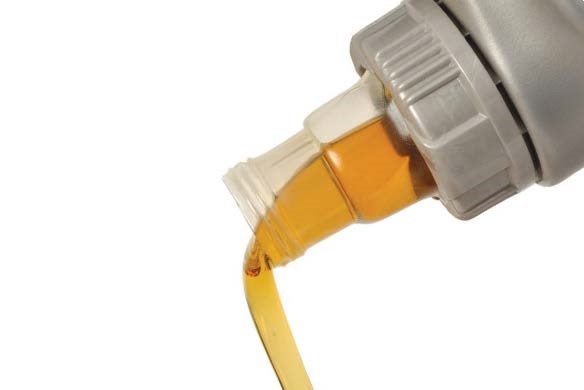Engine oils and low-speed pre-ignition
R. David Whitby | TLT Worldwide September 2015
Carmakers seek to capture the full fuel-increasing and emission-reducing potential of turbocharged engines.

Tests involving the use of engine oils have shown they can be formulated to prevent LSPI while maintaining the oil’s basic performances.
IN THE PURSUIT OF EVER BETTER FUEL ECONOMY, vehicle makers and engine builders have encouraged oil and additive manufacturers to develop lower viscosity and longer life engine and transmission oils.
Over the last two decades, gasoline engine oil viscosities in Europe, North America and Asia have migrated from 20W-50, through 10W-40 and 5W-30, to reach 0W-30 and even 0W-20 in some countries. The latest SAE J300 specification, issued in January 2015, now sets viscosity limits for 0W-16, 0W-12 and even 0W-8 engine oils.
Car manufacturers are using downsized engines—with gasoline direct injection (GDI)—to help improve vehicles’ fuel efficiencies and to reduce emissions, while also using turbochargers to boost power. GDI and turbochargers go together quite well, allowing a downsized and more fuel-efficient gasoline engine to perform as well as (with same peak power) a naturally aspirated engine with higher displacement. GDI enhances power and torque, while allowing a higher compression ratio within spark limits for more thermal efficiency compared with indirect port injection. GDI’s evaporative spray cooling of the hot compressed air charge is also beneficial.
Unfortunately the use of new technology can result in unintended consequences. GDI engines with turbocharging (GDI-T) increase soot-like particles in the oil that can lead to premature engine wear. Higher thermal loads increase engine oil stress from oxidation and nitration.
The use of low viscosity engine oils in GDI-T engines has thrown up another unintended problem: low-speed pre-ignition (LSPI). This is an event that occurs in gasoline vehicle engines when there is a premature ignition of the main fuel charge. LSPI is most common in certain GDI-T engines in vehicles operating in low-speed and high-load driving conditions. These events are random and infrequent. Their effects on vehicles can include very high-pressure spikes, loud knocking noises and sometimes catastrophic engine damage. Vehicles with high technology GDI-T engines need a matching high-performance engine lubricant for maximum protection against premature failure.
The existence of LSPI can limit a car maker’s ability to capture the full potential of turbocharged engines to meet increasing fuel efficiency requirements and to further reduce carbon-dioxide emissions. LSPI in downsized spark-ignition engines has been studied for more than a decade, but only now are definitive explanations beginning to emerge regarding the exact sources of auto-ignition. No single mechanism can explain all the occurrences of LSPI and that each engine should be considered as a particular case supporting different conditions for auto-ignition.
The U.S. Southwest Research Institute (SwRI) launched the two-year Pre-ignition Prevention Program (P3) Consortium in 2011 aimed at understanding the source of LSPI and working toward developing a standardized test for lubricants and/or fuels. The consortium’s objectives included examining the interaction between fuel and oil in LSPI events to understand how hardware design could be used to help mitigate LSPI and to identify fluids that can help reduce LSPI occurrences.
Researchers have been unable to pinpoint a single root cause for all LSPI instances. However, tests involving the use of engine oils have shown they can be formulated to prevent LSPI while maintaining the oil’s basic performances. The major manufacturers of engine oil additives—Lubrizol, Afton Chemical, Infineum and Chevron Oronite—have been assessing several types of formulations to evaluate their impact on LSPI.
Recent studies summarized by Ricardo UK Ltd. indicate that polyalphaolefin base oils have been found to perform particularly well. Calcium-based detergents were shown to have a contributory effect to LSPI, while MoDTC or ZnDTP additives demonstrated a preventative effect.
It was thought that autoignition of the oil would occur initially through vaporization followed by oxidation. However, the NOACK volatility of different base oils was found to have little effect on LSPI. The autoignition temperatures of base oils were measured using Differential Scanning Calorimetry to evaluate their oxidative reactivity. It was found that autoignitive temperature was shown to correlate well with LSPI frequency at elevated pressure. It has been concluded that the oxidation reaction of the oil is crucial to the propensity for LSPI.
Updated oil-performance standards are taking shape to address LSPI. General Motors’ next-generation dexos1™ specification, scheduled for release in 2015, will include an engine test based on a GM 2.0-liter four-cylinder Ecotec engine that will test for LSPI. The proposed ILSAC GF-6 standard, due to be issued at the end of 2015, will also include a test for oil-related LSPI events in gasoline direct-injection engines based on a Ford 2.0-liter four-cylinder Ecoboost engine.
 David Whitby is chief executive of Pathmaster Marketing Ltd. in Surrey, England. You can reach him at pathmaster.marketing@yahoo.co.uk
David Whitby is chief executive of Pathmaster Marketing Ltd. in Surrey, England. You can reach him at pathmaster.marketing@yahoo.co.uk.